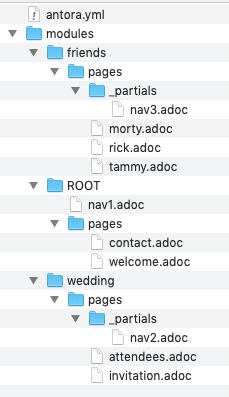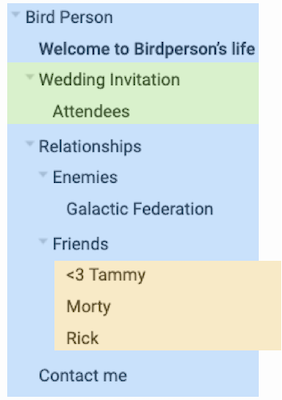Composing navigation files in Antora using the include macro
This third post in the series of Antora posts quickly addresses a feature I only recently discovered. It will show you some techniques you can use to compose the navigation menu in a multi-repository, multi-module setup. This is especially interesting if you have content spread across repositories that you want to present hierarchically in the navigation tree.
Using multiple navigation files
Let us start with the basics: How to combine navigation files?
The Antora docs explain how you can use multiple navigation files for one component by using the nav key in the component descriptor.
However this limits you to the operation of concatenation.

To achieve such concatenation just define your component as
name: bp
title: Bird Person
version: HEAD
nav:
- modules/ROOT/nav1.adoc
- modules/wedding/nav2.adoc
- modules/friends/nav3.adocComposing navigation files by include
In case a plain concatenation does not do it and you want to compose your navigation structure across three different navigation files you can use the include: macro.
This can come in handy if you split content into multiple modules and want to include the content of the modules in varying order in the navigation menu.

In this scenario the component descriptor would reference a single navigation file
name: bp
title: Bird Person
version: HEAD
nav:
- modules/ROOT/nav1.adocBut the navigation file in turn references content from additional supplemental navigation files.
.Bird Person
* xref:welcome.adoc[Welcome to Birdperson's life]
include::wedding:partial$nav2.adoc[
* xref:contact.adoc[Contact me]
link:friends:partial$nav3.adoc[]* xref:wedding:invitation.adoc[Wedding Invitation]
** xref:wedding:attendees.adoc[Attendees]* Friends of Birdperson
** xref:friends:tammy.adoc[<3 Tammy]
** xref:friends:morty.adoc[Morty]
** xref:friends:rick.adoc[Rick]
Given the above navigation files and directory structure you end up with the following navigation tree.
Notice how nav2.adoc is embedded in the content defined in nav1.adoc.
Bird Person
- Welcome to Birdperson’s life
- Wedding Invitation
- Attendees
- Contact me
- Friends of Birdperson
- <3 Tammy
- Morty
- Rick
Important:
For navigation files to be used by include: in Antora you need to place them inside a folder that is indexed by Antora. The suggested solution is storing it as a partial so it does not clutter the actual page space.
Nesting navigation listings across files
There is another interesting scenario of including remote content.
Given our simple example this might seem far-fetched but consider the option of defining a high level list structure in nav1.adoc and filling certain branches of this navigation tree with included files.
In this scenario we want to include the list of Birdperson’s friends but continue the list indentation from nav1.adoc.

By extending Birdpersons relationships also to enemies we want the following nav tree to be rendered:
Bird Person
- Welcome to Birdperson’s life
- Wedding Invitation
- Attendees
- Relationships
- Enemies
- Galactic Federation
- Friends
- <3 Tammy
- Morty
- Rick
- Enemies
- Contact me
For the sake of simplicity we will not add any pages for the Enemies / Galactic Federation entries.
The changed files for this scenario are nav1 and nav3.
.Bird Person
* xref:welcome.adoc[Welcome to Birdperson's life]
link:wedding:partial$nav2.adoc[]
* Relationships
** Enemies
*** Galactic Federation
** Friends
+
--
link:friends:partial$nav3.adoc[]
--
+
* xref:contact.adoc[Contact me]** xref:friends:tammy.adoc[<3 Tammy]
** xref:friends:morty.adoc[Morty]
** xref:friends:rick.adoc[Rick]Notice how nav3.adoc in this case only hosts the sub-elements and not the Friends caption itself.
Using the same directory structure as previously the final rendered result in Antora looks like the nested list we expected to get.

As expected the content of nav2.adoc is included on the same list level as nav1.adoc.
The list of friends from nav3.adoc however continues as a nested indentation within ROOT/nav1.adoc.
The picture below shows the included sections highlighted according to their respective navigation files.

Closing words
Dan Allen posted a fantastic answer to my initial question regarding this issue. I encourage you to read it if you have questions about what happens exactly.
Another neat trick is to reuse component definitions if you are forced to spread documentation across different repositories that you actually want to show up in a common navigation tree.
This might be the case for multi-repository software projects where you want to create one generic software documentation and aggregate by content (e.g. all interfaces in one place).
To achieve this just use the same antora.yml file (same name: and version:) in multiple repositories.
You can view the example directories in github.com/anoff/blog and run the playbook-nest.yml.
If you have any questions or know additional tricks let me know via Twitter or leave a comment 👋
